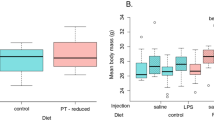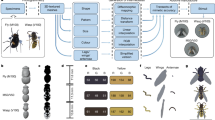Abstract
The sheetweb spider Pityohyphantes phrygianus (Araneae: Linyphiidae) exhibits a continuous variation in dark colouration due to polygenic inheritance of the trait. There are three main phenotype classes: pale, intermediate and melanic. In natural populations, the proportion of melanics seems to be stable at a low frequency, usually 3–4 per cent. An hypothesis about possible selective differences between melanics vs. non-melanics was evaluated in a 2-year field experiment. Bird predation was prevented in a large number of spruce branches, the natural habitat of the species, by means of coarse-meshed nets. The experimental branches and the controls were sampled four times (spring and autumn in 2 years). Bird predation was shown to affect negatively the spider abundance. Removal of bird predation increased the P. phrygianus mean density between 2.3 and 10.5 times the control density. However, no difference in the proportion of melanics in experimental vs. control branches could be established. It is suggested that bird predation is not a major selective force affecting the phenotype proportions. Hence, the mechanism of maintenance of melanism in natural populations of P. phrygianus is unclear, but some alternative explanations are discussed.
Similar content being viewed by others
Article PDF
References
Allen, J A. 1988. Frequency-dependent selection by predators. Phil Trans R Soc Lond B, 319, 485–503.
Askenmo, C, Von Brömssen, A, Ekman, J, and Jansson, C. 1977. Impact of some wintering birds on spider abundance in spruce. Oikos, 28, 90–94.
Avery, M I, and Krebs, J R. 1984. Temperature and foraging success of great tits Pants major hunting for spiders. Ibis, 126, 33–38.
Berry, R J. 1990. Industrial melanism and peppered moths (Biston betularia (L.)). Biol J Linn Soc, 39, 301–322.
Brakefield, P M. 1987. Industrial melanism: Do we have the answers? Trends Ecol Evol, 2, 117–122.
Ekman, J. 1984. Density-dependent seasonal mortality and population fluctuations of the temperate-zone willow tit (Parus montanus). J Anim Ecol, 53, 119–134.
Endler, J A. 1988. Frequency-dependent predation, crypsis and aposematic coloration. Phil Trans R Soc Lond B, 319, 505–523.
Endler, J A. 1991. Interactions between predators and prey. In: Krebs, J. R. and Davies, N. B. (eds) Behavioural Ecology An Evolutionary Approach, 3rd ed, Blackwell Scientific Publications, Oxford, pp. 169–196.
Gillespie, R G, and Tabashnik, B E. 1990. Maintaining a happy face: stable colour polymorphism in the spider Theridion grallator (Araneae, Theridiidae). Heredity, 65, 67–74.
Gunnarsson, B. 1983. Winter mortality of spruce-living spiders: effect of spider interactions and bird predation. Oikos, 40, 226–233.
Gunnarsson, B. 1985. Phenotypic variation in dark coloration in Pityohyphantes phrygianus (C. L. Koch) (Araneae: Linyphiidae). Bull Br Arachnol Soc, 6, 369–374.
Gunnarsson, B. 1987a. Melanism in the spider Pityohyphantes phrygianus (C. L. Koch): the genetics and the occurrence of different colour phenotypes in a natural population. Heredity, 59, 55–61.
Gunnarsson, B. 1987b. Sex ratio in the spider Pityohyphantes phrygianus affected by winter severity. J Zool, Lond, 213, 609–619.
Gunnarsson, B. 1988. Body size and survival: implications for an overwintering spider. Oikos, 52, 274–282.
Gunnarsson, B. 1990. Vegetation structure and the abundance and size distribution of spruce-living spiders. J Anim Ecol, 59, 743–752.
Gunnarsson, B. 1992. Fractal dimension of plants and body size distribution in spiders. Funct Ecol, 6, 636–641.
Gunnarsson, B, and Andersson, A. 1992. Skewed primary sex ratio in the solitary spider Pityohyphantes phrygianus. Evolution, 46, 841–845.
Hippa, H, and Oksala, I. 1982. Definition and revision of the Enoplognatha ovata (Clerck) group (Araneae: Theridiidae). Ent Scand, 13, 213–222.
Howlett, R J, and Majerus, M E N. 1987. The understanding of industrial melanism in the peppered moth (Biston betularia) (Lepidoptera: Geometridae). Biol J Linn Soc, 30, 31–44.
Kettlewell, H B D. 1973. The Evolution of Melanism. Clarendon Press, Oxford, 423 pp.
Lees, D R. 1981. Industrial melanism: Genetic adaptation of animals to air pollution. In: Bishop, J. A. and Cook, L. M. (eds) Genetic Consequences of Man Made Change. Academic Press, London, pp. 129–176.
Mikkola, K. 1984. On the selective forces acting in the industrial melanism of Biston and Oligia moths (Lepidoptera: Geometridae and Noctuidae). Biol J Linn Soc, 21, 409–421.
Oxford, G S. 1983. Genetics of colour and its regulation during development in the spider Enoplognatha ovata (Clerck) (Araneae: Theridiidae). Heredity, 51, 621–634.
Oxford, G S. 1985. A countrywide survey of colour morph frequencies in the spider Enoplognatha ovata (Clerck) (Araneae: Theridiidae): evidence for natural selection. Biol J Linn Soc, 24, 103–142.
Oxford, G S. 1991. Visible morph-frequency variation in allopatric sympatric populations of two species of Enoplognatha (Araneae: Theridiidae). Heredity, 67, 317–324.
Oxford, G S, and Shaw, M W. 1986. Long-term variation in colour-morph frequencies in the spider Enoplognatha ovata (Clerck) (Araneae: Theridiidae): natural selection, migration and intermittent drift. Biol J Linn Soc, 27, 225–249.
Pacala, S, and Roughgarden, J. 1984. Control of arthropod abundance by Anolis lizards on St. Eustatius (Neth. Antilles). Oecologia, 64, 160–162.
Reillo, P R. 1989. Color polymorphism in the spider Enoplognatha ovata (Araneae: Theridiidae): Broad-scale morph-frequency variation in northeastern North America. Am Midi Nat, 111, 199–203.
Reillo, P R, and Wise, D H. 1988a. An experimental evaluation of selection on color morphs of the polymorphic spider Enoplognatha ovata (Araneae: Theridiidae). Evolution, 42, 1172–1189.
Reillo, P R, and Wise, D H. 1988b. Temporal and spatial patterns of morph-frequency variation among costal Maine populations of the polymorphic spider Enoplognatha ovata (Araneae: Theridiidae). Am Midl Nat, 120, 337–354.
Riechert, S E, and Hedrick, A V. 1990. Levels of predation and genetically based anti-predator behaviour in the spider, Agelenopsis aperta. Anim Behav, 40, 679–687.
Schoener, T W, and Toft, C A. 1983. Spider populations: extraordinarily high densities on islands without top predators. Science, 219, 949–952.
Siegel, S, and Castellan, N J. 1988. Nonparametric Statistics for the Behavioral Sciences, 2nd edn, McGraw-Hill, New York, 399 pp.
Spiller, D A, and Schoener, T W. 1988. An experimental study of the effects of lizards on web-spider communities. Ecol Monogr, 58, 57–77.
Waldvogel, J A. 1990. The bird's eye view. Am Sci, 78, 342–353.
Author information
Authors and Affiliations
Rights and permissions
About this article
Cite this article
Gunnarsson, B. Maintenance of melanism in the spider Pityohyphantes phrygianus: is bird predation a selective agent?. Heredity 70, 520–526 (1993). https://doi.org/10.1038/hdy.1993.75
Received:
Issue date:
DOI: https://doi.org/10.1038/hdy.1993.75



